Visual Perception Tests
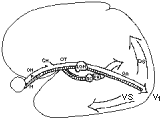
Visual acuity tests are recognition tests requiring analysis of visual information in the primary visual cortex (V1) and in the inferior temporal lobe. In the primary analysis of visual information there can be deficiencies limited to visual functions either in the pathways to the temporal lobe, the ventral stream, (VS) or in the visual associative cortex. Some of these changes in visual form perception can be tested also in children. If the lesion is in the parietal visual functions, it affects eye-hand co-ordination (actually vision-hand movement co-ordination) and perception of egocentric space. For those who want to know more there is a short summary about visual pathways and their function.
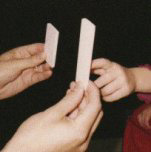
The rectangles in the Rectangles Game are a modification of Efron's rectangles that are used in adult neuropsychology to test the ability to see differences in the length of lines. The total area of each rectangle is the same, so it is not possible to use the luminance of the surface as a measure of the size. The rectangles are designed to test the child's ability to see size differences.
If the child does not seem to understand what is longer and what is shorter based on visual information, the rectangles can be used to teach the child these concept using tactile and haptic information. (Since "haptic information" seems to be unknown by many readers, a short explanation might be helpful. With "haptic information" we mean our ability to perceive size and form with our hands and body. Therefore place two rectangles of different length standing next to each other on the table and demonstrate the child that one of them is outside the other. This one is called longer and the other one is called shorter.) If the child develops these concepts based on haptic information, and yet cannot specify which one is longer and shorter based on visual information, it is likely that the child has problems in recognizing the size differences.
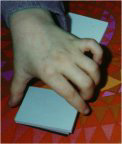
In such a case it is of interest in observing how the child grasps the rectangles: The child is asked to grasp the rectangles one by one. If the distance between the thumb and the forefinger matches the length of the rectangle before the child touches the rectangle, there is visual information available to the planning of hand and finger movements in the parietal lobe although that information does not enter or cannot be analyzed in the temporal lobe.
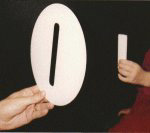
The Mailbox Game can be used to test whether the child can see directions of lines. In the adjacent picture the child can turn the rectangle in the same orientation where the slit is rotated, i.e. the child can analyse visual information and see the spatial orientation or direction of the slit. Some children are unable to perform this task, yet when asked to post a card or the rectangle through the slit, they turn the card in correct orientation well in advance of touching the surface of the mailbox. In these cases parietal visual information for the hand movements is available although visual information does not reach or cannot be analysed in the inferotemporal lobe (ventral stream).
Heidi Expressions can be used to teach visually impaired children about facial expressions and also to test whether the child can see them at high and lower contrasts. Some children with brain damage cannot see the difference in these black and white pictures although they can see facial expressions in real life.
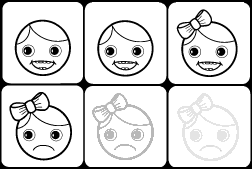
|

|
The above test situations need to be completed by a careful case history and observation of the child's functioning in every day tasks. Whenever there is an uneven profile of functioning, i.e. in some tasks the child performs well in other tasks of similar difficulty poorly or not at all, the nature of visual information available to the child needs to be assessed before one concludes that "the child does not understand the task". If visual information is lacking or distorted, the task is not presented in its usual way.
For more information see the Introduction to the LEA Tests for Cognitive Vision
Paediatric Vision Tests I Vision Tests I Instructions Section I Main Page